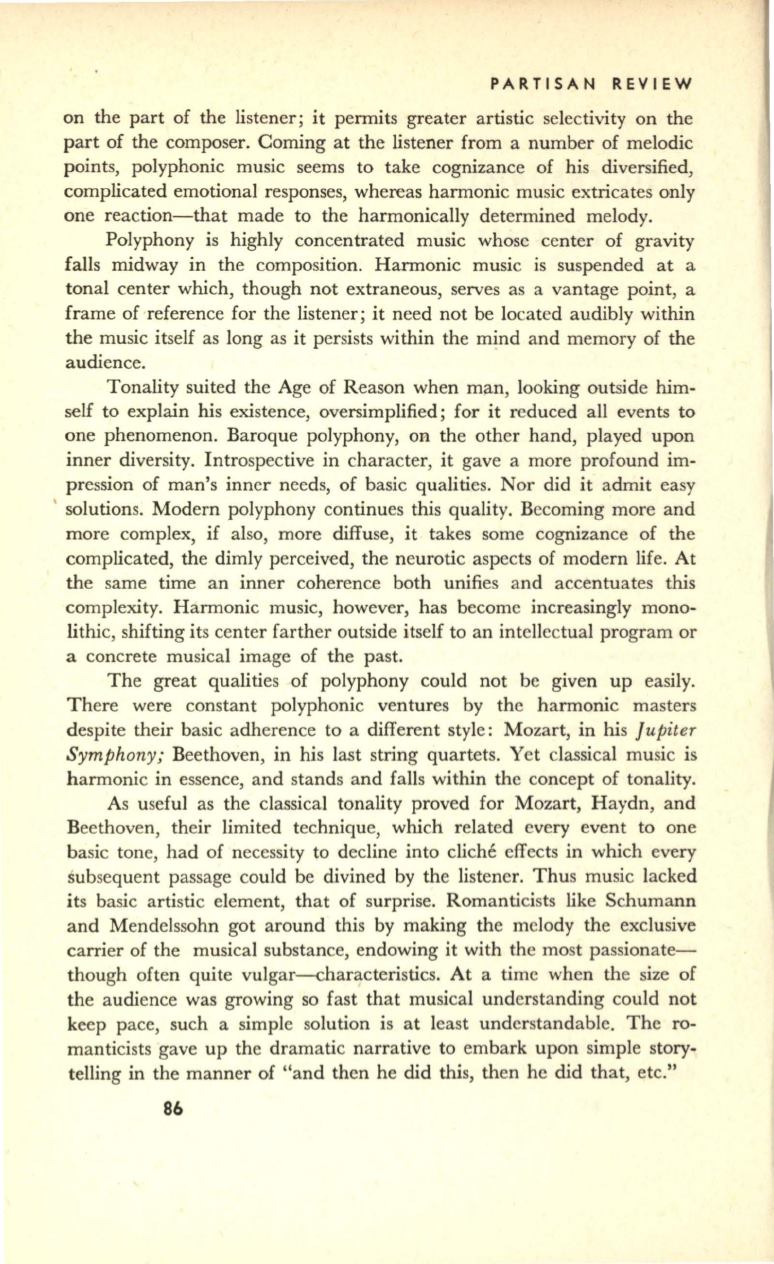
PARTISAN REVIEW
on the part of the listener; it permits greater artistic selectivity on the
part of the composer. Coming at the listener from a number of melodic
points, polyphonic music seems to take cognizance of his diversified,
complicated emotional responses, whereas harmonic music extricates only
one reaction-that made to the harmonically determined melody.
Polyphony is highly concentrated music whose center of gravity
falls midway in the composition. Harmonic music is suspended at a
tonal center which, though not extraneous, serves as a vantage point, a
frame of reference for the listener; it need not be located audibly within
the music itself as long as it persists within the mind and memory of the
audience.
Tonality suited the Age of Reason when man, looking outside him–
self to explain his existence, oversimplified; for it reduced all events to
one phenomenon. Baroque polyphony, on the other hand, played upon
inner diversity. Introspective in character, it gave a more profound im–
pression of man's inner needs, of basic qualities. Nor did it admit easy
solutions. Modern polyphony continues this quality. Becoming more and
more complex, if also, more diffuse, it takes some cognizance of the
complicated, the dimly perceived, the neurotic aspects of modern life. At
the same time an inner coherence both unifies and accentuates this
complexity. Harmonic music, however, has become increasingly mono–
lithic, shifting its center farther outside itself to an intellectual program or
a concrete musical image of the past.
The great qualities of polyphony could not be given up easily.
There were constant polyphonic ventures by the harmonic masters
despite their basic adherence to a different style: Mozart, in his
Jupit er
Symphony;
Beethoven, in his last string quartets. Yet classical music is
harmonic in essence, and stands and falls within the concept of tonality.
As useful as the classical tonality proved for Mozart, Haydn, and
Beethoven, their limited technique, which related every event to one
basic tone, had of necessity to decline into cliche effects in which every
subsequent passage could be divined by the listener. Thus music lacked
its basic artistic element, that of surprise. Romanticists like Schumann
and Mendelssohn got around this by making the melody the exclusive
carrier of the musical substance, endowing it with the most passionate–
though often quite vulgar-<:haracteristics. At a time when the size of
the audience was growing so fast that musical understanding could not
keep pace, such a simple solution is at least understandable. The ro–
manticists gave up the dramatic narrative to embark upon simple story–
telling in the manner of "and then he did this, then he did that, etc."
86


